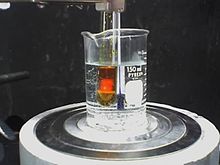- 2,4-Dinitrophenylhydrazine
-
2,4-Dinitrophenylhydrazine 

 (2,4-dinitrophenyl)hydrazineOther names2,4-DNPH; 2,4-DNP; Brady's reagent
(2,4-dinitrophenyl)hydrazineOther names2,4-DNPH; 2,4-DNP; Brady's reagentIdentifiers CAS number 119-26-6 
ChemSpider 3001507 
KEGG C11283 
ChEMBL CHEMBL352799 
Jmol-3D images Image 1 - c1cc(c(cc1[N+](=O)[O-])[N+](=O)[O-])NN
Properties Molecular formula C6H6N4O4 Molar mass 198.14 Appearance Red or orange powder Melting point 198 - 202 °C dec.
Solubility in water Slight Hazards MSDS MSDS Main hazards Flammable, possible carcinogen  (verify) (what is:
(verify) (what is:  /
/ ?)
?)
Except where noted otherwise, data are given for materials in their standard state (at 25 °C, 100 kPa)Infobox references 2,4-Dinitrophenylhydrazine (DNPH, Brady's reagent) is the chemical compound C6H3(NO2)2NHNH2. Dinitrophenylhydrazine is relatively sensitive to shock and friction; it is a shock explosive so care must be taken with its use. It is a red to orange solid, usually supplied wet to reduce its explosive hazard. It is a substituted hydrazine, and is often used to qualitatively test for carbonyl groups associated with aldehydes and ketones. The hydrazone derivatives can also be used as evidence toward the identity of the original compound.
Contents
Synthesis
2,4-Dinitrophenylhydrazine is commercially available usually as a wet powder. It can be prepared by the reaction of hydrazine sulfate with 2,4-dinitrochlorobenzene:[1]
Brady’s reagent is prepared by dissolving 2,4-dinitrophenylhydrazine in a solution containing methanol and some concentrated sulfuric acid.
Brady's test
2,4-Dinitrophenylhydrazine can be used to qualitatively detect the carbonyl functionality of a ketone or aldehyde functional group. A positive test is signaled by a yellow or red precipitate (known as a dinitrophenylhydrazone.) If the carbonyl compound is aromatic, then the precipitate will be red; if aliphatic, then the precipitate will have a yellow color.[2] The reaction between 2,4-Dinitrophenylhydrazine and a ketone is shown below:
- RR'C=O + C6H3(NO2)2NHNH2 → C6H3(NO2)2NHNCRR' + H2O
This reaction can be described as a condensation reaction, with two molecules joining together with loss of water. It is also considered an addition-elimination reaction: nucleophilic addition of the -NH2 group to the C=O carbonyl group, followed by the removal of a H2O molecule.
The mechanism for the reaction between 2,4-dinitrophenylhydrazine and an aldehyde or ketone is shown below:[3]
Crystals of different hydrazones have characteristic melting and boiling points, allowing the identity of a substance to be determined in a method known as derivatization. In particular, the use of 2,4-dinitrophenylhydrazine was developed by Brady and Elsmie.[4] Modern spectroscopic and spectrometric techniques have since superseded these techniques.
Dinitrophenylhydrazine does not react with other carbonyl-containing functional groups such as carboxylic acids, amides, and esters. For carboxylic acids, amides and esters, there is resonance associated stability as a lone-pair of electrons interacts with the p-orbital of the carbonyl carbon resulting in increased delocalization in the molecule. This stability would be lost by addition of a reagent to the carbonyl group. Hence, these compounds are more resistant to addition reactions.
See also
- Tollens' reagent
- Fehling's reagent
References
- ^ Allen, C. F. H. (1943), "2,4-Dinitrophenylhydrazine", Org. Synth., http://www.orgsyn.org/orgsyn/orgsyn/prepContent.asp?prep=cv2p0228; Coll. Vol. 2: 228
- ^ http://wiki.colby.edu/download/attachments/110920618/Experiment+%232.pdf?version=1&modificationDate=1265312071267
- ^ Adapted from Chemistry in Context, 4th Edition, 2000, Graham Hill and John Holman
- ^ Brady, O. L.; Elsmie, G. V. (1926). "The use of 2:4-dinitrophenylhydrazine as a reagent for aldehydes and ketones". Analyst 51 (599): 77–78. doi:10.1039/AN9265100077.
Hydrazines 4-PTSC • Acylhydrazine • ADH • Adjudin • Agaritine • Benmoxin • Cadralazine • Carbazide • Carbazone • Carbidopa • Carbohydrazide • Daminozide • Dihydralazine • DNPH • Endralazine • Gyromitrin • HBT • Hydralazine • Hydrazide • Hydrazine • Hydrazone • IDH • Iproclozide • Iproniazid • Isocarboxazid • Isoniazid • Mebanazine • Metfendrazine • MMH • Nialamide • Octamoxin • PEH • Phenelzine • Pheniprazine • Phenoxypropazine • Phenylhydrazine • Pimagedine • Pivalylbenzhydrazine • Procarbazine • Safrazine • SDH • Semicarbazide • Semicarbazone • SDMH • Tetrafluorohydrazine • Thiosemicarbazide • Thiosemicarbazone • UDMHCategories:- Nitrobenzenes
- Reagents for organic chemistry
- Hydrazines
Wikimedia Foundation. 2010.



